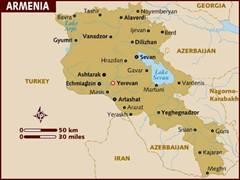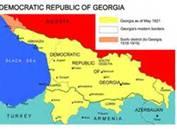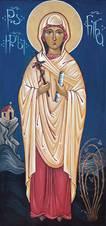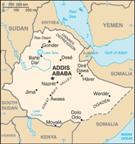National Churches: Armenia, Georgia, and Ethiopia
WEEK 4: ARMENIA, GEORGIA, AND ETHIOPIA

ARMENIA
Geography:
Armenia is a small country, south of Georgia and north of Iran; historically it was much larger. Its capital is Yerevan. Armenia has some of the most rugged terrain in the region – the Caucasus Mountains. The climate is dry, with long, cold winters and short, hot summers. Most of the population is Christian. They grow apricots, peaches, grapes, walnuts, barley and wheat and mine copper in the mountains.
History:
Armenia was ruled by Persia and then Greece for centuries. Finally, King Tigran ruled an empire that stretched from the Caspian to the Mediterranean in 95 BC. But, it was not to last. Armenia was conquered by Rome in 55 BC.
Shortly after the fall of Rome, Armenia was again conquered, this time by the Arabs in the 600s. But, she gained independence as an Armenian kingdom again in 884. The Kingdom of Armenia lasted for centuries.
In the 1300s, the west of Armenia was conquered by the Turks and the east by the Persians. The Turks were to rule until their defeat in World War I. Their rule was one of genocide and discrimation. The Persians were replaced by the Russians in 1828. During World War I, the Turks deported most ethnic Armenians to the desert, where a million were killed, the rest fled to the eastern half of the country. In 1918, eastern Armenia formed an independent republic, only to be annexed by the Soviet Union until its collapse. Western Armenia remains a part of Turkey.
St. Gregory the Illuminator of Armenia:
 For many years, Tirdat, young King of Armenia, lived in Rome. His father, King Khosrov of Armenia, had been killed by an angry murderer in 224 AD. He grew up with a good friend, Diocletian – later to be the Diocletian of the most vicious persecution of Christians in the history of the Roman Empire. Finally, King Tirdat was coming home to his land of Armenia. On the way, he met a young man named Gregory, who had been raised in Caesarea by a Christian nurse. Young King Tirdat liked Gregory and invited him to come to Armenia with him and be in his court. Gregory went with Tirdat. Neither Gregory nor Tirdat knew a terrible secret: Gregory was the son of the murderer!
For many years, Tirdat, young King of Armenia, lived in Rome. His father, King Khosrov of Armenia, had been killed by an angry murderer in 224 AD. He grew up with a good friend, Diocletian – later to be the Diocletian of the most vicious persecution of Christians in the history of the Roman Empire. Finally, King Tirdat was coming home to his land of Armenia. On the way, he met a young man named Gregory, who had been raised in Caesarea by a Christian nurse. Young King Tirdat liked Gregory and invited him to come to Armenia with him and be in his court. Gregory went with Tirdat. Neither Gregory nor Tirdat knew a terrible secret: Gregory was the son of the murderer!
Soon they were home to Armenia. What a celebration! The Armenian people cheered for their young king as he rode through the streets. Tirdat went right away to the statue of the goddess Anahid, goddess of the earth. He put a wreath in front of the statue and worshipped the statue. All the other people did the same – all but Gregory. Gregory was a Christian. He told King Tirdat that he worshipped only Jesus, the Son of God.
King Tirdat was very angry. How dare Gregory disobey him, the king? He even found out that Gregory was the son of his father’s murderer. He ordered Gregory thrown into prison. There Gregory stayed for 15 years in a dark pit. Have you been alive even that long? An old woman secretly brought the Christian prisoner food. After many years, King Tirdat became ill. His sister loved her brother and had dreams about the young man in prison. Maybe Gregory could help her brother, the king. She made up her mind to send for Gregory to be brought to the palace. There Gregory prayed for King Tirdat and he was healed.
Now that Gregory was out of prison, he began to tell the Armenian people about Jesus. He wanted to build churches for them to worship the Lord. One day he saw a vision of a column of fire with a cross on top. Here he would build his church Etchmiadzin – the first in all Armenia. Soon there were churches all over the country. Gregory went everywhere, telling people about the Christian faith, building churches, and helping the poor.
King Tirdat and all his family gathered by the river. One by one they were baptized by Gregory, now a bishop, and had communion for the first time. Armenia was now a Christian country. And the king who had thrown Gregory into prison became his greatest helper and friend. Gregory died at age 82. We call Gregory “Enlightener” because he brought God’s light to the Armenian people.
Armenian Orthodox Church:
Armenia was originally evangelized by the apostles Thaddeus and Bartholomew – remember their journeys from earlier in the year? The country became the first Christian nation with the ministry of St. Gregory.
In the 6th century, the Armenian Church adopted the Monophysite heresy and broke away from the Orthodox faith, along with the Egyptian Coptic Church. Later, the Georgian branch returned to orthodoxy, but the Armenian church, with its Patriarch in Echmiadzin, remained heterodox. While under Turkish domination, the Turks insisted that the authority of the Patriarch of Constantinople extend to all Orthodox Christians in his Empire, regardless of jurisdiction. But, since the Turkish downfall, the Armenian Church has again organized with the supreme Patriarch in Echmiadzin (where St. Gregory built his first church) and bishops in Istanbul, Jerusalem, Syria, and Lebanon for the Armenian populations of those countries.
Small numbers of Armenian students arrived in the 1830s to study in American universities. But immigration began in earnest in the 1880s to escape Turkish oppression. In the aftermath of the 1915 Armenian Genocide, peak numbers of immigrants arrived. While Armenia remained under Soviet domination, few people were allowed to leave the country, but immigration has started again with the demise of the Soviet Union and the establishment of a free Republic of Armenia. There are now two Armenian dioceses in the US, serving about a million Armenians.
Ethnic traditions:
Armenian food is complex to prepare and includes various shish kebabs and pilafs, lots of lamb, stewed dried fruit as a New Year’s pudding, baklava, and stuffed grape leaves. Perhaps try lamb kebabs in class with students choosing their own ingredients and grilling on the church grill.
 GEORGIA:
GEORGIA:
Geography: Georgia is located in the South Caucasus mountains; in fact, most of the land is made up of mountains and plateaus. The deepest cave in the world, the Krubera Cave, is located in Georgia. The climate varies from humid, subtropical in the western lowlands, to frost throughout the year in the highest mountains. The capital of Georgia is Tbilisi.
History: In very ancient times before Christ, Georgia was comprised of two kingdoms, Colchis and Iberia. In fact, Colchis is named as the site of the Golden Fleece sought by Jason and his Argonauts in Greek mythology. The two kingdoms were united under one king in the 4th century BC, and later became part of the Roman Empire.
Because of the Christianization of the Georgian state, it remained a faithful ally of the Byzantine Empire until it was captured by the Arabs in the 7th century. Bagrat III reunited the country in the 11th century, and Georgian culture flourished in the 12th and 13th centuries. The Golden Age of Georgia was presided over by King David the Builder, and later his granddaughter, Queen Tamar. But, in the 15th century the country, attacked on all sides by various enemies, disintegrated into many small kingdoms and regions, passing from hand to hand with one conqueror after another.
In 1800 Georgia was annexed by treaty as a part of the Russian Empire. But, after the Russian Revolution in 1917, Georgia declared its own independence from Russia in 1918. But, in 1921 the Russian troops attacked and conquered Georgia, establishing it as the Georgian Soviet Socialist Republic. In 1991, with the collapse of the Soviet Union, Georgia was again independent.
Georgian Orthodox Church:
St. Nina, Equal to the Apostles
 St. Nina was of godly parents, a descendant of St. George. Her parents moved to Jerusalem, where there were many Georgian people living, and she spent her education reading the Bible and praying. One day, she wondered where the tunic of the Lord had been taken? She was told that it was in the land of Georgia (then called Gruzia), and that that land had not yet heard of Christ. From that day on, she prayed that the people of Georgia would become Christian and that she would be able to find the tunic of the Lord. One night, she had a dream; the Theotokos appeared to her, gave her a cross woven with grapevines, and told her to go to Georgia to tell the people there about her Son. When Nina awoke, the cross of vines was in her hands. She received permission from her uncle, the Patriarch of Jerusalem, to travel to Georgia, and arrived there in 319 AD. There, on the Feast of the Transfiguration, St. Nina prayed while the pagan priests held a service to the idols of the people on a high mountain, and a storm came and toppled the idols. Then, the wife of the emperor, Queen Nana, became very ill; Nina prayed and touched her forehead with the twig-cross and she was healed. But, still, the emperor did not believe in the Lord Jesus. Finally, the sun became dark, and he was struck blind! The terrified king and his people prayed first to their idols, but all remained dark. They then called out to the God preached by Nina, and light returned. And, so, on May 6, 319 AD, the emperor Mirian, and all of his courtiers, were baptized; by 324 the entire country had been converted to Christianity. Thus Nina is known as Equal to the Apostles. St. Nina did find the tunic of the Lord, and the first Christian church in the country was built on its site.
St. Nina was of godly parents, a descendant of St. George. Her parents moved to Jerusalem, where there were many Georgian people living, and she spent her education reading the Bible and praying. One day, she wondered where the tunic of the Lord had been taken? She was told that it was in the land of Georgia (then called Gruzia), and that that land had not yet heard of Christ. From that day on, she prayed that the people of Georgia would become Christian and that she would be able to find the tunic of the Lord. One night, she had a dream; the Theotokos appeared to her, gave her a cross woven with grapevines, and told her to go to Georgia to tell the people there about her Son. When Nina awoke, the cross of vines was in her hands. She received permission from her uncle, the Patriarch of Jerusalem, to travel to Georgia, and arrived there in 319 AD. There, on the Feast of the Transfiguration, St. Nina prayed while the pagan priests held a service to the idols of the people on a high mountain, and a storm came and toppled the idols. Then, the wife of the emperor, Queen Nana, became very ill; Nina prayed and touched her forehead with the twig-cross and she was healed. But, still, the emperor did not believe in the Lord Jesus. Finally, the sun became dark, and he was struck blind! The terrified king and his people prayed first to their idols, but all remained dark. They then called out to the God preached by Nina, and light returned. And, so, on May 6, 319 AD, the emperor Mirian, and all of his courtiers, were baptized; by 324 the entire country had been converted to Christianity. Thus Nina is known as Equal to the Apostles. St. Nina did find the tunic of the Lord, and the first Christian church in the country was built on its site.
To this day, the vast majority of the country belongs to the Orthodox faith. The Georgian Orthodox Church gained autocephaly (or self-government) in the Middle Ages, but was abolished during the Russian rule. The church was again recognized officially in 1990 by the Ecumenical Patriarch.
Ethnic traditions: The country of Georgia is so-named by the Western world, possibly due to their reverence for St. George. They call themselves Kartvelians and their country Sakartvelo. The Georgian language is an ancient language of the Caucasus region unrelated to other European or Asian languages, and Georgia boasts three unique alphabets.
Winemaking and agriculture are a major part of the economy. The best known dish is Khinkali, or meat dumplings, and, of course, wine. At a Supra, or Georgian dinner/feast, a “tamada” or toastmaster is selected to keep the toasts moving and the party interesting. Perhaps you might try a small Supra in class, with a student or the teacher serving as tamada and each toasting the others with glasses of grape juice.
 ETHIOPIA:
ETHIOPIA:
Geography:
Ethiopia lies in northeast Africa, bordering the Red Sea. Its name, “Ethiopia,” comes from the Greek for “sunburned faces.” The people of Greece, accustomed to the Egyptians, were puzzled by the black skin of the Ethiopians! Ethiopia was also known early as Cush or Abyssinia. Most of Ethiopia consists of rugged mountains with a high plateau. It has a dry, hot climate and has suffered through many droughts, causing severe famines. Its plains are populated with giraffes, elephants, lions, and antelope. Tropical rain forests cover parts of the southwest near equatorial Africa.
The capital of Ethiopia is Addis Ababa. It has a population of about 1 ½ million people. Most of the people of Ethiopia live in rural areas. They farm with wooden plows pulled by oxen, just like their ancestors and live in mud huts with straw roofs. Textiles are the main export industry. The northern part of the country is composed mostly of Semitic people and the southern of Cushite. There are also several thousand “Black Jews”.
History:
Ethiopia had until recently the oldest existing kingdom in the world. Its first emperor was Menelik I, son of the Biblical Queen of Sheba and King Solomon of Israel. Review this story, if time permits. The Aksum Kingdom was well-established even in the days of the Romans; it reached its height in the 300s under King Ezana. Under Menelik II in the 1800s, expansion by Italy was stopped and Addis Ababa became capital. But, in 1935, the Italians conquered Ethiopia and Emperor Haile Selassie had to flee to exile in England. The British in World War II helped the Ethiopians drive out the Italians and returned Haile Selassie to Addis Ababa. The descendants of Solomon and the Queen of Sheba ruled for 2000 years, until, in 1974, Emperor Haile Selassie was overthrown by a military junta.
St. Frumentius:
Once there lived a boy in the land of Phoenicia named Frumentius. Now, Phoenicia is on the sea and the people of that land are good sailors. So, a rich man named Meropius decided that he would sail to India to learn of the wisdom of that land. Meropius took with him 2 boys, Frumentius and his friend Edesius. But, the ship ran out of food. They came to a town on the coast of Africa and landed the ship to buy food. But the people of this region hated the Romans. They killed Meropius and the sailors and took the two boys to the king as slaves. This is how Frumentius came to the African land of Ethiopia.
Now, there were already Jews and Christians in Ethiopia. Do you remember the story of the Queen of Sheba? She visited King Solomon and their son became king of Ethiopia. Many Jews settled there. And, do you remember the story of Philip and the eunuch of Ethiopia? He also returned home and taught people about Jesus. But, the king was not a Christian.
The king could see that the boys were smart and well-mannered. He decided to let them live as his servants. Edesius became his cup-bearer and Frumentius a keeper of scrolls. They served the king well. But, the king died young. The queen asked Edesius and Frumentius to help her young son learn to rule the land and they agreed to serve the people of Ethiopia. Frumentius was now free to travel around the country. He gathered the Christians together and told people about Jesus. Soon, there were more and more Christians in the land.
Frumentius traveled to Alexandria to meet with the young bishop, Athanasius. Review the story of Athanasius and the council of Nicea. Frumentius told Athanasius how much the people of Ethiopia needed a bishop to build churches and teach. Athanasius could see the love of the Lord and His people of Ethiopia in the eyes of Frumentius. Frumentius himself was ordained bishop and sent back to Ethiopia!
King Ezana, the young boy, had grown into a man. He also became a Christian because of Frumentius. We know this because of the coins of the land. Those from his early reign have pagan half moons on them; those from his later life have crosses.
Like his friend Athanasius, Frumentius did not follow the false teachings of Arius. Do you remember what those were? He continued to build churches and teach the true faith. When Athanasius was taken prisoner, the followers of Arius came also for Frumentius. But, the people of Ethiopia so loved their “Aboona”, or father, that they would not let him be taken prisoner. He is remembered in Ethiopia to this day as the “Revealer of Light”.
Coptic Church:
Jewish beliefs (and Jewish believers) were common in Ethiopia from the days of the Queen of Sheba. Review this story in your Old Testament.
The first evangelization of Ethiopia occurred with the conversion of the queen’s minister by Philip on the Road to Gaza. Review this story as well in the book of Acts.
The country became Christian under King Ezana with the evangelization of St. Frumentius, discussed above. Even in the days of St. Frumentius, the Church in Ethiopia looked to the Patriarch of Alexandria for spiritual guidance. Thus, with the Monophysite controversy, the Church of Ethiopia, along with the Alexandria and the Egyptian (Coptic) Church, refused to accept the teachings of the 4th Council and separated from the Orthodox Church.
Ethiopians have settled heavily in Bermuda, where there is an active Coptic church. From there, more than directly from Ethiopia, immigrants have come to the US.
Ethnic traditions:
Ethiopians eat a thick, spicy stew called “wat”, often picking it up with a sour bread called “injera”.
Quiz Questions:
- Compare and contrast these two very different cultures.
- These churches are not Orthodox: explain.